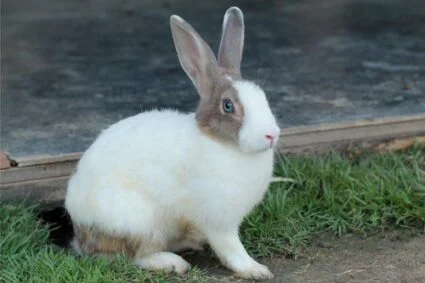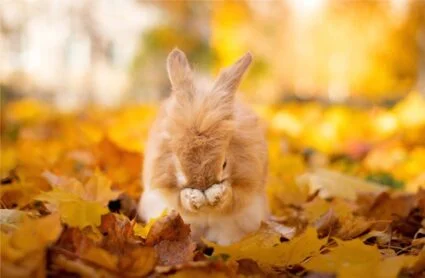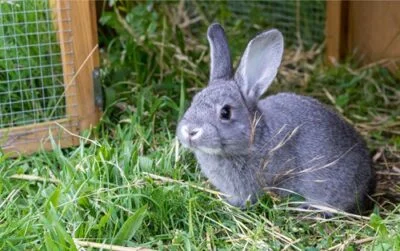Excessive drooling in rabbits, accompanied by other symptoms, such as weight loss, may be an indicator of ptyalism. Ptyalism is more than the average rabbit slobber that comes from the mouth during grooming, eating, and drinking. It also usually lasts for more than a few minutes.
There are many causes of excessive drooling in rabbits, such as misaligned teeth and overheating. Ongoing salivation is often a sign of pain. This can occur if your rabbit has dental issues such as gingivitis, congenital malocclusion of teeth, stomatitis, and periapical abscesses. The ingestion of toxic substances and neurological issues may also cause ptyalism in rabbits.
Ptyalism can cause moist dermatitis and alopecia around the face and neck area. If your rabbit shows signs of hypersalivation, see a veterinarian. Your vet will check the inside of your rabbit’s mouth for dental issues. Share any concerns about your rabbit, such as recent changes in its diet.
What Are the Causes of Excessive Salivation in Rabbits?
| Causes of Excessive Drooling | Signs and Symptoms |
|---|---|
| Malocclusion of Teeth (Overgrown Teeth) | – Drooling – Weight loss from not eating due to pain – Eye discharge – Fecal deposits in your rabbit’s bottom |
| Heatstroke | – Panting Reddening of the ears – Lethargy – Weakness or slow movement – Confusion – Trembling or shaking – Convulsions |
| Tooth Abscess | – Oral cavityLoose teeth – Abnormal teeth or bite alignment – Overgrown incisor – Oral tissue swelling – Preference for soft foods – Extreme loss of weight – Respiratory irritation – Signs of pain/discomfort. A lack of interest in moving, hiding, lethargy, and depression |
| Pneumonia | – Excessive salivation – Anorexia – Weight loss – Lethargy – Fever – Sneezing – Intolerance to exercise – Nose and/or eye discharge – Facial abscesses – Difficulty breathing |
| Poisoning | – Hypersalivation – Seizures – Digestive signs (intestinal inflammation) – Loss of body temperature regulation – Lethargy and listlessness – Loss of appetite – Depression |
Dental Concerns
Numerous conditions contribute to excessive drooling in rabbits. Among the larger categories is dental disease. Note that some rabbit breeds have a much higher chance of developing dental issues. These often include dwarf rabbits and lop-eared rabbits.
Knowing your rabbit’s genetic history can help you rule out the cause of your rabbit’s excessive salivation. If your rabbit has a family history of dental concerns or diseases, there’s a high risk for it to develop dental issues as well.
Furthermore, rabbits that don’t consume enough grass hay have a higher incidence of dental issues. Another cause for dental problems in rabbits can be trauma or injury to the teeth.
Most dental problems, whether it involves an injury or a disease, will cause severe pain in rabbits. Your rabbit may respond to pain with an excess amount of drool. Therefore, hypersalivation in rabbits is often a cause for concern, especially if it is accompanied by signs of pain and changes in eating habits.
Malocclusion of Teeth
Your rabbit’s teeth are continuously erupting or getting longer. However, they aren’t usually described as growing teeth. This is because rabbits have a supply of extra tooth that’s waiting to come out from below the gum line. Rabbits are highly susceptible to overgrown teeth.
The premolars and molars are collectively called cheek teeth in rabbits. The occlusal surface (top of the tooth) of a rabbit’s cheek teeth should be directly opposite to each other. This gives the rabbit an effective “grinding surface” while it munches on delicious hay.
About 80% of a rabbit’s diet should consist of high-quality grass hay. Grass hay and some leafy greens contain a lot of fiber, which means they require plenty of side to side jaw movement. This helps file down the cheek teeth, preventing overgrown teeth in rabbits.
Unfortunately, most domestic diets are given pelleted diets that don’t require much chewing. Without enough substance to grind the teeth, your rabbit can suffer from overgrowths, which when painful, are called spurs.
These spurs cut into the cheeks and tongue, causing debilitating ulceration in your rabbit. The intense pain can cause your rabbit to lose interest in eating, causing weight loss and lethargy, making the condition even worse.
Sometimes rabbits can suffer from congenital malocclusion of teeth. This means they are born with misaligned teeth or poor jaw alignment. Some breeds are more prone to malocclusion of teeth than others, especially dwarf and lop rabbits. Trauma is another cause of overgrown teeth.
Look out for the following signs if you suspect your rabbit is suffering from overgrown teeth:
- Drooling
- Weight loss, typically from not eating due to pain
- Eye discharge
- Feces are collecting around the tail or anus. When rabbits are in pain and not eating, they may pass partially digested food that sticks to their fur and avoid grooming
How to Prevent Overgrown Teeth in Rabbits
Overgrown teeth are preventable and treatable, if your rabbit already suffers from it. Here’s what you can do to ensure your rabbit’s teeth are in great shape:
- Rabbit’s diet. High-quality grass hay and leafy greens as daily treats will keep your rabbit munching all day. This will help tame those pesky erupting teeth. Hay and grasses are packed with vitamins A and D and calcium, which also help improve your rabbit’s dental health. Deficiencies in these nutrients can cause dental problems, according to The Veterinary Record.
- Regular checkups. There may be times when your rabbit’s teeth will have to be trimmed back by your vet or be removed entirely if needed. Occasionally, dental issues are so severe that your vet may have to refer your rabbit to a specialist.

Other Teeth Problems
Other dental causes that lead to excessive drooling in rabbits include:
- Infections of the teeth
- Split of fractured teeth
- Molar spurs
- Stomatitis
- Gingivitis, or inflammation of the gums
- Abscess in the mouth or gums
In some cases, ptyalism may occur in rabbits suffering from central or autonomic nervous system disorders that send signals to the salivary glands to produce excess saliva.
Heatstroke
Drooling is a common sign of heatstroke in rabbits, among other symptoms. It’s not surprising that rabbits are susceptible to heatstroke. Rabbits have dense or long fur coats, and some are overweight, too young, or too old. This makes them more likely to suffer from overheating.
Owners should pay attention to signs of overheating in rabbits, regardless of the risk. Rabbits tend to hide when they’re in distress. They also try their best to avoid showing signs of pain and weakness. This is a well-polished skill in rabbits that prevents them from being hunted from predators looking for an easy meal.
So, how does a heatstroke happen in rabbits? Heatrokes occur when rabbits get too hot. This is most common in summer months when the temperature is so high that a rabbit’s body may struggle to keep it cool. When a rabbit’s body temperature gets too high, it can become life-threatening.
According to Michigan State University, a rabbit’s normal body temperature is 102 to 103 degrees Fahrenheit. Rabbits cannot tolerate high temperatures as well as they can with cold temperatures.
If a temperature approaches 80 degrees Fahrenheit, it can cause severe distress. Without first aid and treatment, your rabbit’s organs may shut down, eventually resulting in death. If you suspect that your rabbit may be overheating, follow these steps:
- Monitor your rabbit’s breathing. Check if your rabbit appears to be breathing rapidly or panting. It may be taking fast shallow breaths with its mouth open. Flared nostrils may accompany this and/or tossing the head from side to side while struggling to breathe.
- Check for drooling. Your rabbit is too focused on breathing, so it may forget that it needs to swallow. This can cause hypersalivation. You’ll notice your rabbit drooling if the fur around its nose and nostrils are wet. Difficulty breathing and drooling are strong indicators of heatstroke.
- Look for behavioral changes. If your rabbit is overheating, you may notice that it is behaving differently even if you cannot pinpoint the exact cause yet. Your rabbit may appear listless, confused, disoriented, or distressed. If your rabbit is stressed, take care while handling it. Excess or rough handling can cause more stress, resulting in further issues.
- Check your rabbit’s movements. If your rabbit is suffering from heatstroke, it won’t move much. Any movement it does make will be slow and probably uncoordinated. Your rabbit may have a bit of a wobble or weakness in its legs. Some rabbits also shiver, shake, tremble, or have convulsions when they’re overly hot.
- Check your rabbit’s ears. Rabbit ears have a radiator effect, according to the Food and Agriculture of the United Nations. Heatstroke can cause the tiny blood vessels in your rabbit’s ears to dilate, giving the ears a red or flushed appearance. Your rabbit’s ears may also feel hot to the touch.
Heatstroke can be prevented in rabbits by taking measures to keep them cool. These include:
- Housing your rabbits indoors, especially during the hotter parts of the day.
- Ensuring that your rabbit has access to plenty of water.
- Placing your rabbit’s hutch in a well-shaded area.
- Providing cooling tools, such as a bottle of frozen water, a ceramic tile or a cooling pad to keep your rabbit cool.
- Misting your rabbit’s ears every now and then.
- Not handling your rabbit and causing stress during the warmer part of the day.
Medical Condition
Excessive salivation can occur due to an underlying medical problem. However, this is rare in rabbits. Some conditions that may cause drooling in rabbits include:
- Respiratory problems
- Pneumonia
- Neurological disorders that cause facial paralysis
- Poisoning or ingestion of toxic substances
- Central/nervous system disorders
Note that rabbits cannot vomit. Therefore, the excessive production of saliva does not originate from the stomach. In some cases, paralysis of the larynx can lead to excessive salivation. After eating, food and saliva may accumulate in the esophagus and regurgitate through the mouth and nose. This regurgitated saliva can enter the airways and lead to pneumonia.
Hypersalivation is rarely associated with pneumonia or other primary respiratory issues. However, if saliva and food enter the airways of a rabbit, pneumonia can occur.
Secondary or fungal infections can also cause drooling under the chin or on the dewlap.

What Are the Signs of Excessive Drooling in Rabbits?
In addition to excessive production of saliva, your rabbit may experience symptoms that present over time. Your rabbit may show some of the following signs or symptoms or all of them, depending on the cause. A few signs to watch out for include:
- Wet mouth, chin or wet dewlap
- Hair loss around the mouth or dewlap (alopecia)
- Thickened skin folds
- Lack of grooming
- Wet fur
- Irritated skin
- Decreased appetite
- Weight loss
- Lethargy
- Lack of interest in play
- Signs of pain or discomfort
- Teeth grinding
- Nasal discharge
- Eye discharge
You may be able to palpate a bulging lump along your rabbit’s jaw bone. This is often a sign of an infection at the root of the teeth, indicating the presence of an abscess. Secondary tongue lesions or gum ulcerations may accompany excessive drooling as well.
Diagnosis
Your vet will look at the inside of the mouth to rule out any obvious concerns associated with hypersalivation. These can include overgrown teeth, injured teeth, mouth lesions, something being stuck in the teeth, etc. In some cases, vets may need to check rabbits for signs of dental concern under anesthesia.
Your vet will ask for a history of your rabbit’s health, any concerns you may have noticed, and family history, if possible. You must identify any changes or concerns in your rabbit to discuss with your vet as this can help them make a diagnosis.
A few concerns to keep in mind and discuss with your vet include recent changes in your rabbit’s diet or eating habits, changes in your rabbit’s poop, changes in grooming behavior, lethargy, any injury or trauma, environmental changes, changes in your rabbit’s hutch, etc.
Your vet may request further testing, such as X-rays and CT scans. These tests will allow your vet to determine the presence of any infections, abscesses, or similar concerns that may be linked with your rabbit’s drooling. Blood tests will be requested to rule out underlying conditions that may cause excessive drooling as a symptom.
Treatment
Treatment for drooling in rabbits is largely dependent on what is causing it. If an infection is contributing to hypersalivation in your pet, your vet may prescribe antibiotics to treat the root cause. The prescribed antibiotics may be an injection or oral medication.
If a tooth is infected, your vet may have to extract it. With overgrown teeth, your vet may recommend bringing your pet for regular checkups to have its teeth trimmed down. However, your vet may also discuss the possibility of extraction as rabbits do not cope well with pain management.
If your rabbit is overheating, take it to your vet immediately. While you are getting ready to leave, make sure you take steps to cool and calm your rabbit. This includes moving your rabbit to a cool and well-ventilated area and spraying its ears and belly with cool water. Overheating is easier to prevent than it is to treat, so make sure your rabbit is kept in a cool place during warmer days.
Recovery
Your vet may recommend changing your rabbit’s diet to ensure its teeth are in great health and to prevent overgrown teeth in the future. Changes in the diet that can help promote proper dental hygiene include providing a large supply of high-quality hay and leafy greens in moderation. Your vet may also recommend avoiding pellets as they do nothing to control overgrown teeth.
Make sure there are enough chewing objects and toys available to help wear down your rabbit’s teeth. Avoid leaving painted, treated, or varnished wood as they’re harmful to rabbits when ingested.
Check your rabbit’s teeth on a regular basis. This will allow you to find changes and concerns during their early stages, when treatment is much easier.
If your rabbit has a higher risk of dental problems, regular veterinary visits are advisable. Keep up with any changes in your rabbit’s diet or behavior, and any physical changes between visits. If your rabbit has a chronic dental disease, it will require lifelong treatment and care to manage symptoms.

